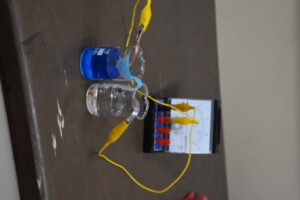Adam Maxwell
In Year 12 Chemistry the students are studying electrochemical cells called galvanic cells. In an experiment we created a galvanic cell called the Daniell cell, which was invented by a British chemist in 1836. Daniell produced electricity from a chemical reaction between zinc metal and copper solution. He separated the reaction into two half reactions in separate beakers called half cells. The two half cells are connected by an external wire and an internal salt bridge to complete the circuit. The electrons are forced to move through the external wire from one half cell to the other to complete the reactions. The movement of these electrons creates a current which is electricity. In the experiment, the students could measure the voltage produced using a voltmeter, which provided evidence that electricity was being produced. The students could see that the heat normally released from a chemical reaction was being harnessed to form an electrical current. Chemical energy was being transformed into electrical energy in a controlled environment.
Galvanic cells have been used in batteries as a source of electrical power for many years. It is also the basis for fuel cells which are commonly used today. Modern technology is using galvanic cells and fuel cells to provide an efficient and cheap continuous supply of energy, by combining a fuel with oxygen.
Galvanic cells are a solution to the issues faced with the burning of fossil fuels, like petrol and diesel for transport. Galvanic technology is used in both battery cars and hydrogen cars. This new technology can provide clean, efficient and renewable energy. Hydrogen fuel cell cars and battery cars are the future, as we reduce our reliance on fossil fuels, which pollute the environment and are a finite resource.
Many international companies have invested in galvanic cell technology to find an alternative to fossil fuels. It will be interesting to see who wins the technology race. The Tesla battery operated cars or the Japanese car companies who have invested heavily in hydrogen powered cars.


